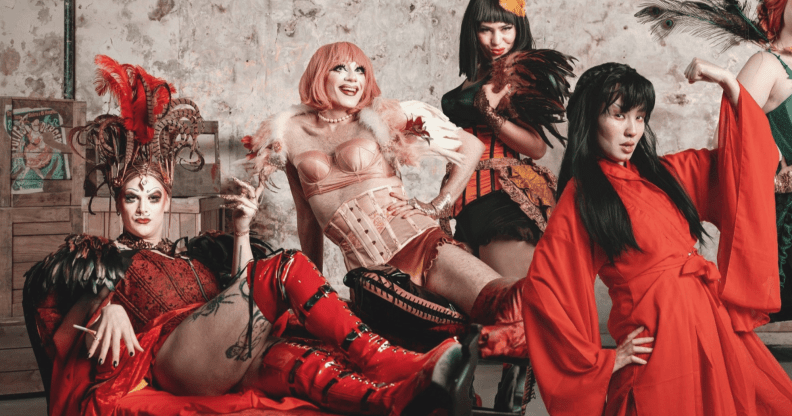‘Filthy’, joyful Mulan Rouge drag show reclaims Disney princess for queer Asians

Mulan Rouge. (Supplied)
A new mash-up of Disney’s Mulan and Baz Luhrman’s Moulin Rouge is a “filthy, stupid and fun” antidote to cultural appropriation.
The story of Mulan has been told and retold for more than 1,500 years, with the first recorded version of the tale appearing in China around the 6th century.
Disney adapted the story as an animated film in 1998. It was a milestone in representation, but has been criticised for appropriating and attempting to westernise Chinese culture, and for disrespecting the original story.
The 2020 live-action remake attempted to fix some of those wrongs, putting Chinese and American-Chinese actors, though many were disappointed that the film was “too white behind the camera” (according to its (white) director Niki Caro, she was hired because she was able to handle mixing Chinese culture with “the culture of Disney”, whatever that means).
Now, a new retelling of the story comes in the form of Mulan Rouge, written and directed by Shay Shay, a non-binary performer and founder of drag troupe The Bitten Peach.
It’s all part of their mission to improve Asian representation in the arts in the UK, going beyond tokenistic invitations to putting Asian excellence front and centre in predominantly white and queer spaces.
Mulan has long been an LGBTQ+ icon, ShayShay explains to PinkNews. In all versions of the story, Mulan is a young woman who pretends to be a man to serve in the army. As she escaped the gendered expectations placed on her, Mulan embraces her true self.
“There are a lot of trans masc people who feel like: ‘This is my story,'” says ShayShay.
“Especially with the song that Mulan sings early in the film, when she’s wondering: ‘Who is that girl I see staring straight back at me?’
“She’s somehow saying: ‘When I obey the gender rules that are pushed upon me, why does it feel like it’s not me?’”
Mulan Rouge follows Mulan’s journey (played by the wonderful Ella Cumber) of faking her identity and going to war in place of her father – but that’s where the expected ends. Think glitz, glamour and go-go girls.
The idea for the show first came to ShayShay a decade ago. It evolved into its current form, which celebrates not just drag queens, but performers of all genders, thanks to the diverse London drag scene ShayShay encountered when they moved to the city.
“I moved to London after I finished university [in the US], and when I went to queer clubs and bars I started to see a form of drag that really resonated with me,” ShayShay explains.
“Seeing trans people doing drag, seeing women doing drag, and seeing people who did not necessarily want to look like women but more like art pieces and aliens was so inspiring. That’s when I was like: ‘Oh, drag is like professional dressing up.'”
The script is filled with clever, queer jokes – “You can be anything! Demi-boy, Demi-girl, Demi Lovato” – delivered by talented queens, kings and performers in gorgeous costumes.
As well as championing queer Asian talent, ShayShay advocates for drag of all shapes and sizes.
Although television has made a certain kind of drag mainstream, they would like to see the art of drag enter the more elitist spaces.
“The RuPaul’s Drag Race empire continues to grow and I feel like drag has infiltrated fashion a lot more,” they say.
“Some queens have managed to get roles in films as actors, but I’m hoping there will be more to come and beyond just drag queens.
“I’m focusing my energy on what I can personally do to make a change. What shows can I make featuring drag performers in non-club spaces? We need drag kings and non-binary drag performers, and just artists working on drag in many different ways.”
The hilarious trio of drag kings on stage in Mulan Rouge definitely falls into that category.
A political piece with many layers to unfold, it is a show full of comedy and good heart. Or, to use ShayShay’s words: “It is filthy, stupid and fun.”
Mulan Rouge shows at The Vaults, London until August 28.
Amended to remove an inaccurate line about the number of Asian performers on-stage.

